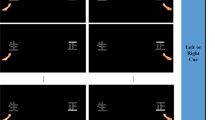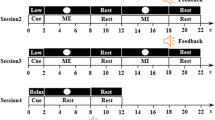Abstract
Mental imagination is the essential part of the most EEG-based communication systems. Thus, the quality of mental rehearsal, the degree of imagined effort, and mind controllability should have a major effect on the performance of electro-encephalogram (EEG) based brain-computer interface (BCI). It is now well established that mental practice using motor imagery improves motor skills. The effects of mental practice on motor skill learning are the result of practice on central motor programming. According to this view, it seems logical that mental practice should modify the neuronal activity in the primary sensorimotor areas and consequently change the performance of EEG-based BCI. For developing a practical BCI system, recognizing the resting state with eyes opened and the imagined voluntary movement is important. For this purpose, the mind should be able to focus on a single goal for a period of time, without deviation to another context. In this work, we are going to examine the role of mental practice and concentration skills on the EEG control during imaginative hand movements. The results show that the mental practice and concentration can generally improve the classification accuracy of the EEG patterns. It is found that mental training has a significant effect on the classification accuracy over the primary motor cortex and frontal area.






Similar content being viewed by others
References
Aftanas LI, Golosheykin SA (2005) Impact of regular meditation practice on EEG activity at rest and during evoked negative emotions. Int J Neurosci 115:893–909
Aftanas LI, Lotova NV, Koshkarov VI, Makhnev VP, Popov SA (1998) Non-linear dynamic complexity of the human EEG during evoked emotions. Int J Psychophysiol 28:63–67
Behncke L (2004) Mental skills training for sports: a brief review. Online J Sport Psychol 6(1)
Bhattacharya J, Petsche H (2001) Shadows of artistry: cortical synchrony during perception and imagery of visual art. Cogn Brain Res 13:179–186
Burke DP, Kelly SP, Chazal P, de Reilly RB, Finucane C (2005) A parametric feature extraction and classification strategy for brain–computer interfacing. IEEE Trans Neural Syst Rehabil Eng 13:12–17
Culpepper BJ, Keller RM (2003) Enabling computer decisions based on EEG input. IEEE Trans Neural Syst Rehabil Eng 11:354–360
Decety J (1996) The neurophysiological basis of motor imagery. Behav Brain Res 77:45–52
Erfanian A, Mahmoudi B (2005) Real-time ocular artifacts suppression using recurrent neural network for electroencephalogram based brain computer interface. Med Biol Eng Comput 43:296–305
Haselsteiner E, Pfurtscheller G (2000) Using time-dependent neural networks for EEG classification. IEEE Trans Rehabil Eng 8:457–463
Hinterberger T Neumann N, Kübler A, Pham M, Grether A, Hofmayer N, Wilhelm B, Flor H, Birbaumer N (2004) The thought translation device: comparison of different feedback modalities for brain-computer communication. Exp Brain Res 154:521–526
Hinterberger T, Schmidt S, Neumann N, Mellinger J, Blankertz B, Curio G, Birbaumer N, (2004) Brain–computer communication and slow cortical potentials. IEEE Trans Biomed Eng 51:1011–1018
Jeannerod M (1994) The representing brain: neural correlates of motor intention and imagery. Behav Brain Sci 17:187–245
Jeannerod M (1995) Mental imagery in the motor context. Neuropsychologia 33:1419–1432
Kübler A, Nijboer F, Mellinger J, Vaughan TM, Pawelzik H, Schalk G, McFarland DJ, Birbaumer N, Wolpaw JR (2005) Patients with ALS can use sensorimotor rhythms to operate a brain-computer interface. Neurology 64:1775–1777
Makeig S (1993) Auditory event-related dynamics of the EEG spectrum and effects of exposure to tones.Electroencephalogr Clin Neurophysiol 86:283–293
Marshall L, Mölle M, Fehm HL, Born J (1998) Scalp recorded direct current brain potentials during human sleep.Eur J Neurosi 10:1167–1178
Mason SG, Birch GE (2000) A brain-controlled switch for asynchronous control applications.IEEE Trans Biomed Eng 47:1297–1307
Mason LI, Alexander CN, Travis FT, Marsh G, Orme-Johnson DW, Gackenbach J, Mason DC, Rainforth M, Walton KG (1997) Electrophysiological correlates of higher states of consciousness during sleep in long-term practitioners of the transcendental meditation program. Sleep 20:102–110
McFarland DJ, McCane LM, Wolpaw JR (1998) EEG-based communication and control: short-term role of feedback. IEEE Trans Rehabil Eng 6:7–11
Middendorf M, McMillan G, Calhoun G, Jones KS (2000) Brain–computer interfaces based on the steady-state visual-evoked response. IEEE Trans Rehabil Eng 8:211–214
Millán J, del R, Mouriño J, Franzé M, Cincotti F, Varsta M, Heikkonen J, Babiloni F (2002) A local neural classifier for the recognition of EEG patterns associated to mental tasks. IEEE Trans Neural Syst Rehabil Eng 13:678–686
Palaniappan R, Paramesran R, Nishida S, Saiwaki N (2002) A new brain-computer interface design using fuzzy ARTMAP. IEEE Trans Neural Syst Rehabil Eng 10:140–148
Perez-De-Abeniz A, Holmes J (2000) Meditation: Concepts, effect and uses in therapy. Int J Psychother 5:49–58
Pfurtscheller G, Neuper C (2001) Motor imagery and direct brain-computer communication. Proc IEEE 89:1123–1134
Pfurtscheller G, Neuper C, Schlögl A, Lugger K (1998) Separability of EEG signals recorded during right and left motor imagery using adaptive autoregressive parameters. IEEE Trans Rehabil Eng 6:316–325
Pfurtscheller G, Leeb R, Keinrath C, Friedman D, Neuper C, Guger C, Slater M (2006) Walking from thought. Brain Res 1071:145–152
Pregenzer M, Pfurtscheller G (1999) Frequency componenet selection for an EEG-based brain to computer interface. IEEE Trans Neural Syst Rehabil Eng 7:413–419
Ramoser H, Müller-Gerking J, Pfurtscheller G (2000) Optimal spatial filtering of single trial EEG during imagined hand movement. IEEE Trans Rehabil Eng 8:441–446
Serby H, Yom-Tov E, Inbar GF (2005) An improved P300-based brain-computer interface. IEEE Trans Neural Syst Rehabil Eng 13:89–98
Uhi F, Goldenberg G, Lang W, Lindinger G, Steiner M, Deecke L (1990) Cerebral correlates imaginging colours, faces and a map-II. Negative cortical DC-potentials. Neuropsychologia 28:81–93
Wolpaw JR, Ramoser H, McFarlan DJ, Pfurtscheller G (1998) EEG-based communication: improved accuracy by response verification. IEEE Trans Rehabil Eng 6:326–333
Wolpaw JR, McFarland DJ, Vaughan TM (2000) Brain–computer interface research at the Wadsworth Center. IEEE Trans Rehabil Eng 8:222–226
Yom-Tov E, Inbar GF (2002) Feature selection for the classification of movements from single movement-related potentials. IEEE Trans Neural Syst Rehabil Eng 10:170–177
Zar JH (1999) Biostatistical analysis. Prentice-Hall, Inc.
Author information
Authors and Affiliations
Corresponding author
Rights and permissions
About this article
Cite this article
Mahmoudi, B., Erfanian, A. Electro-encephalogram based brain–computer interface: improved performance by mental practice and concentration skills. Med Bio Eng Comput 44, 959–969 (2006). https://doi.org/10.1007/s11517-006-0111-8
Received:
Accepted:
Published:
Issue Date:
DOI: https://doi.org/10.1007/s11517-006-0111-8




